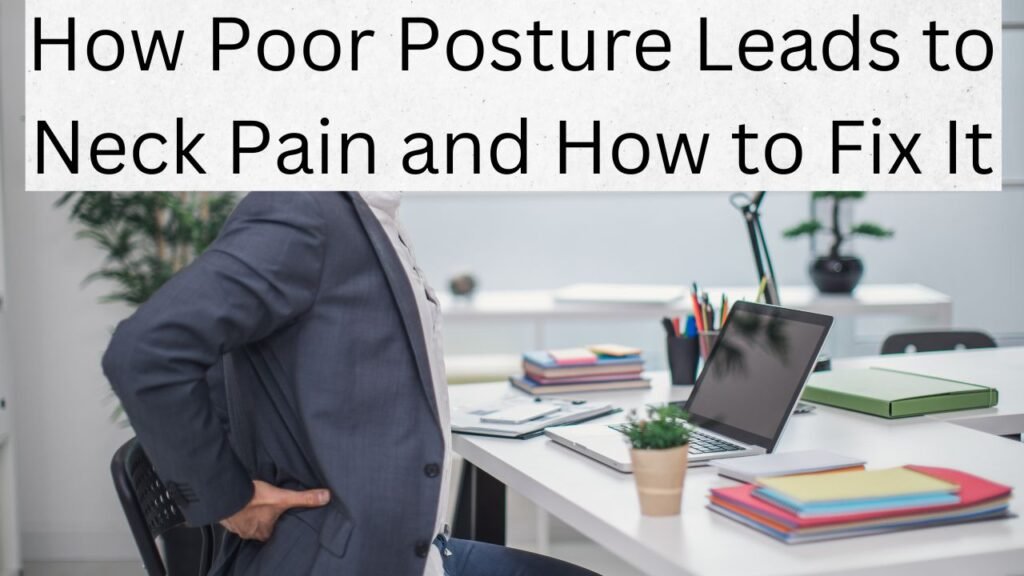Neck pain has become a common issue in today’s world. With people spending long hours at desks, looking down at phones, or slouching on couches, poor posture is a leading cause of discomfort. Many don’t realize how bad posture can strain the neck and lead to chronic pain. Understanding the connection between posture and neck pain is the first step to finding relief.

How Poor Posture Affects the Neck
The human spine has a natural curve that helps balance the body’s weight. However, when posture is poor, the spine is forced into unnatural positions. This puts extra stress on the muscles, ligaments, and joints of the neck.
Forward Head Posture (Tech Neck)
One of the most common posture problems is forward head posture, often called “tech neck.” It happens when the head juts forward while using a phone, computer, or even reading a book. The average human head weighs about 10-12 pounds, but with forward head posture, the effective weight on the neck can increase up to 50-60 pounds. This excessive strain leads to muscle fatigue, stiffness, and pain.
Slouching and Rounded Shoulders
Slouching while sitting or standing can also contribute to neck pain. When the shoulders round forward, the head tends to follow, pulling the neck out of alignment. Over time, this posture weakens the back muscles while tightening the chest and neck muscles, leading to discomfort and reduced mobility.
Sleeping Position Issues
Poor sleeping posture can also strain the neck. Using a pillow that’s too high or too flat, or sleeping on your stomach, forces the neck into awkward angles. This can cause stiffness and pain in the morning.
Symptoms of Neck Pain from Poor Posture
Neck pain caused by bad posture doesn’t always appear immediately. It develops gradually as stress accumulates in the muscles and joints. Some common symptoms include:
- Persistent neck stiffness and soreness
- Headaches, often originating from the base of the skull
- Reduced range of motion in the neck
- Shoulder pain or upper back discomfort
- Tingling or numbness in the arms due to nerve compression
If left untreated, chronic poor posture can lead to conditions like cervical disc degeneration, nerve compression, and even long-term mobility issues.
How to Fix Poor Posture and Relieve Neck Pain
Correcting posture and making small lifestyle changes can significantly reduce neck pain. Here’s how you can start improving your posture and relieving discomfort:
1. Maintain Proper Ergonomics
Setting up a workspace with good ergonomics can prevent neck pain. Follow these guidelines:
- Keep the computer screen at eye level to avoid looking down.
- Use a chair with proper back support to prevent slouching.
- Place the keyboard and mouse at a comfortable height to reduce strain on the shoulders and neck.
- Use a headset or speakerphone instead of cradling the phone between your shoulder and ear.
2. Strengthen Neck and Shoulder Muscles
Weak muscles make it harder to maintain proper posture. Strengthening exercises help support the neck and prevent pain. Some effective exercises include:
- Chin Tucks: Gently tuck the chin in and hold for a few seconds to strengthen the deep neck muscles.
- Shoulder Blade Squeezes: Pull the shoulder blades together and hold to improve upper back strength.
- Neck Isometrics: Press your head against your hand in different directions to build neck muscle endurance.
3. Stretch to Reduce Tension
Stretching helps loosen tight muscles and improve mobility. Daily stretches can relieve stiffness and restore flexibility.
- Upper Trapezius Stretch: Gently tilt your head to one side, bringing your ear toward your shoulder to stretch the side of the neck.
- Levator Scapulae Stretch: Rotate the head slightly downward and gently pull it toward the chest.
- Chest Opener Stretch: Stretch the chest and shoulders by clasping your hands behind your back and lifting slightly.
4. Maintain Good Posture Throughout the Day
Being mindful of posture is key to long-term relief.
- Keep the ears aligned with the shoulders when standing or sitting.
- Avoid looking down at phones for long periods; hold the device at eye level.
- Take frequent breaks from sitting by standing and stretching every 30-60 minutes.
5. Improve Sleep Posture
Proper sleeping posture ensures the neck stays in a neutral position.
- Use a pillow that supports the natural curve of the neck.
- Avoid sleeping on the stomach, as it forces the head into an unnatural position.
- Side sleepers should use a pillow that keeps the head aligned with the spine.
6. Consider Professional Treatment
If neck pain persists despite self-care efforts, seeking professional help may be necessary. Treatment options include:
- Physical Therapy: A physical therapist can guide posture correction and targeted exercises.
- Chiropractic Care: Chiropractors can adjust spinal alignment and relieve tension in the neck.
- Massage Therapy: Massaging tight muscles can reduce stiffness and improve circulation.
- Posture Training Devices: Wearable posture correctors can help maintain proper alignment throughout the day.
Final Thoughts
Poor posture is a major contributor to neck pain, but it’s a problem that can be corrected. Making small adjustments to how you sit, stand, and sleep can lead to significant relief. Strengthening and stretching exercises can further support the neck and shoulders. By practicing better posture habits daily, you can prevent chronic pain and improve overall well-being. If pain persists, consulting a healthcare professional ensures the right treatment for long-term relief. Start making these changes today and experience the benefits of a pain-free neck.